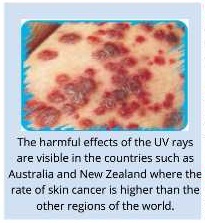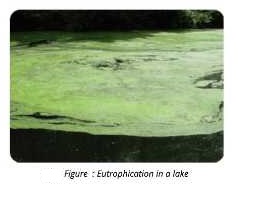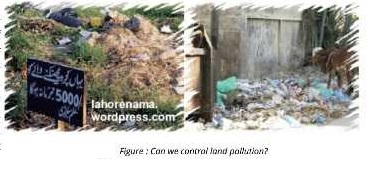Q.10 Define and explain different types of Pollution.
Answer:
Definition
Pollution is defined as any undesirable change in the physical, chemical or biological characteristics of air, water and land that may harmful for humans, other living organisms and natural resources. Pollutants
• The agents which are responsible for pollution are called pollutants.
Types of Pollutants
Pollutants are of two types i.e. biodegradable and non-biodegradable.
Sources of pollutants
They may be the industrial effluents, domestic wastes, medical wastes.
Examples
CO2, CO, SO2, CFCs etc.
Types of Pollution
A) Air Pollution
Definition
It is defined as the change of composition in the air by the addition of harmful substances (e.g.
industrial and automobile gases and particulate matter).
Sources of Air Pollution
All sources of air pollution are related to human activities. Burning of coal produces a lot of smoke and dust whereas burning of petroleum produces sulphur dioxide. In addition to these, air pollutants include the carbon monoxide, carbon dioxide, nitrogen oxides, hydrocarbons, particulate matter and traces of metals. Different industries produce air pollution in the following ways:
• Fertilizer Industries
Fertilizer industries release oxides of sulphur and nitrogen, hydrocarbons, particulate matter and fluorine.
• Thermal Industries
Thermal industries are coal based and their pollutants are fly ash, soot and sulphur dioxide.
• Textile Industries
Textile industries release cotton dust, nitrogen oxides, chlorine, smoke and sulphur dioxide.
• Steel Industries
Steel industries release carbon monoxide, carbon dioxide, sulphur dioxide, phenol, fluorine, cyanide, particulate matter etc.
Effects of air Pollution
1. Global Warming
It is known that global warming is one of the consequences of air pollution. According to estimates, at the current rate of increase, the average global temperature will go up by 3°C to 8C in next 100 years. Other effects of air pollution are as follows:
2. Smog Formation
When pollutants like hydrocarbons and nitrogen oxides combine in the presence of sunlight, smog is formed. This is a mixture of gases. It forms a yellowish brown haze especially during winter and hampers visibility. It also causes many respiratory disorders and allergies as it contains polluting gases.
3. Acid Rains
The air pollutants like sulphur. dioxide and nitrogen oxides react with water vapours in the atmosphere producing acid rains.
4. Ozone Depletion
Upper layer (stratosphere) of the atmosphere has ozone (03) which absorbs ultraviolet rays – present in the sun’s radiations. However the air pollutants like chlorofluorocarbons (CFCs) destroy the ozone molecules and so break the ozone layer. Ozone holes are created which permit UV rays to reach the Earth’s surface. The UV rays increase the temperature and also cause skin cancers.

The harmful effects of the UV rays are visible in the countries such as Australia and New. Zealand where the rate of skin cancer is higher than the other regions of the world.
Control of Air Pollution
For effective control of air pollution, it is important to create public awareness about the ill effects of air pollution. Air pollution can be controlled by following ways
1) Afforestation .
It means the establishment of new forests by planting on non-forest areas. Forests are effective means to control-air pollution because plants can filter and absorb air pollutants.
2) Modification of industrial effluents
The air pollutants coming from industries should be passed through filters and other devices, so that the particulate matter is removed before the waste gases are released out. The smoke producing units should have long chimneys to take the polluting gases far above and then disperse over a larger area. Industries should
3) Environment friendly fuels
Lead-free fuels should be used in automobiles. Similarly sulphur-free fuel should be used in. ‘coal-based industry to reduce pollution by sulphur dioxide.
B) Water Pollution
Definition
It is the change in the composition of water by the addition of harmful substances. Water pollution severely affects the health of people.
Sources of Water Pollution
• Sewage
Sewage is one of the major pollutants of water. It contains organic matter and the excreta of
humans and other animals.
Organic matter encourages the growth of micro-organisms which spread diseases.
• Industrial Wastes
i. The wastes of industries (acids, alkalis, dyes and other hemicals) are disposed in nearby water bodies. These wastes change the pH of water and are harmful or even fatal to aquatic
organisms.
ii. Certain industries release a lot of hot water from their cooling plants. It results in heating
up of water bodies and kills aquatic life.
• Fertilizers and Pesticides
Fertilizers and pesticides enter into water bodies with the rain water flow and the ground water by seepage. These chemicals remain in water for a long time and can enter food chains. They cause a number of diseases in animals..
• Petroleum Hydrocarbons
Oil tankers and offshore petroleum refineries cause oil leakage into water. Oil floats on the water surface and prevents atmospheric oxygen from mixing in water. So, aquatic animals begin to die due to shortage of oxygen.
• Heavy Metals
Some heavy metals e.g. Lead, Mercury, Arsenic and Cadmium also make the water polluted., Such metals can be present in the water, released from industrial and urban areas. If water with such heavy metals is given to plants, the metals enter the vegetables that grow on these plants. Such contaminated vegetables are harmful for human health.
Diseases in humans
i. Heavy metals reduce growth and development, and cause cancer and nervous system
damage.
ii. Mercury and Lead can cause joint diseases such as rheumatoid arthritis, diseases of … Kidneys, circulatory system and nervous system.
Tanneries
There are more than 200 tanneries (industry where raw skin is treated to make leather) operating in Kasur city.
(a) Industrial Discharge
The industry discharges 9000 cubic meters of water daily into the nearby water bodies. This water contains heavy metals and becomes the part of the underground water.
(b) Effects
(i) In 2003, a survey showed that two-thirds of residents and 72% of tannery workers suffered
cancer, infections of the Kidneys, or loss of eyesight.
(ii) Tests showed that the drinking water was contaminated with Lead, Mercury and
Chromium.
(c) Kasur Tannery Pollution control project
Pakistan government and the United Nations development programme (UNDP) launched the Kasur tannery pollution control project. The project has established an effluent treatment plant, chromium plant and a solid waste disposal site.
Effects of water pollution
The followings are the major effects of water pollution.
I. Eutrophication
Enrichment of water with inorganic nutrients (nitrates and phosphates) is called eutrophication. The sewage and fertilizers contain large amount of inorganic materials. When sewage and fertilizers reach water bodies, the nutrients present in them promote algal blooms (excessive growth) there. Rich algal growth leads to increase in the number of decomposers.

Harmful effects of eutrophication
1) Decomposers use the oxygen present in water and it results in the depletion of oxygen.
2) Algal bloom also reduces the light reaching the lower layers of water.
II. Food chain Contamination
The non-biodegradable water pollutants may stay in water for long times. From water, they enter into small organisms, which are fed upon by fish. The fish in turn are fed upon by land animals including humans.
III. Epidemics
Organic pollutants in water facilitate the growth of germs. Such polluted water causes epidemics like cholera, gastroenteritis etc.
Control of Water Pollution
The following methods should be used to control water pollution
1) Public should be made aware of the dangers of water pollution.
2) Before releasing the sewage into water bodies, it must be treated through sewage treatment : : techniques.
3) Industrial wastes should also be treated before they are released into water bodies.
C) Land Pollution
Definition
It is the change in the composition of land (soil) by the addition of harmful substances. Land is an important resource as it is the basis for the growth of producers. In the recent times, soil. has been subjected to the pollution.
Causes of Land Pollution
1) The pesticides used in agriculture have chemicals that stay in soil for long times.
2) The acid rains change the pH of soil making it unsuitable for cultivation.
3) The household and other city garbage lies scattered in soil in the absence of a proper
disposal system.
4) Materials like polythene block the passage of water into soil and so decrease the water
holding capacity of soil.

5) Many industries produce harmful chemicals which are disposed off without being treated.
6) Improper disposal of nuclear wastes also causes radioactive substances to remain in soil
for a long time.
7) Open latrines in villages and some part of the cities are also the source of land pollution.
Control of Land Pollution
• There should be suitable and safe disposal of wastes including nuclear wastes.
• Non- biodegradable materials like plastic, glass, metals etc. should be recovered and recycled.
• Inorganic pesticides should be replaced by organic pesticides.
D) Noise Pollution
Definition
Unwanted, unpleasant and annoying sounds are termed as noise, Noise is also considered as a form of pollution.
Effects
Annoyance and aggression, hearing loss, depression, hypertension etc.
![]()